The Charm of Gold Victorian Engagement Rings
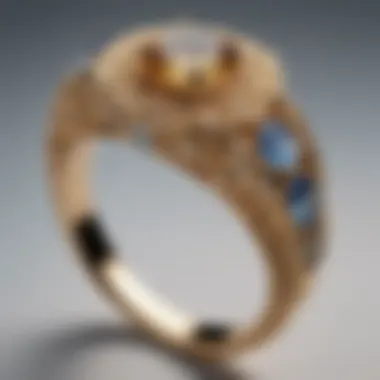
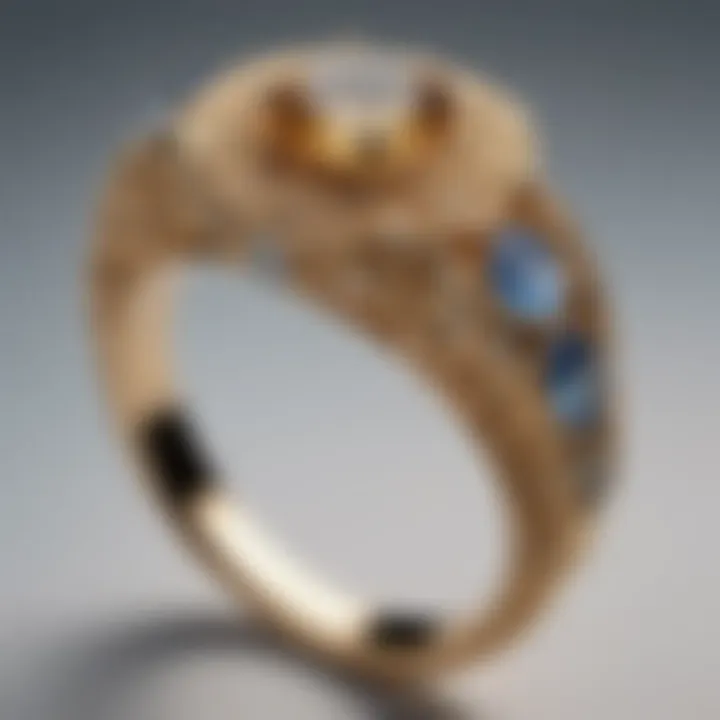
Intro
Gold Victorian engagement rings have long captivated the hearts and minds of jewelry enthusiasts, serving as a vivid reminder of an era rich with artistic expression and intricate craftsmanship. Each ring tells a story—an interplay of enduring romanticism and historical significance. These pieces are more than mere adornments; they symbolize commitments, values, and even aspirations. In exploring the allure of these rings, we peel back layers of history, artistry, and enduring charm.
As we journey through the world of gold Victorian engagement rings, expect to uncover not only the craftsmanship and design intricacies but also the emotional narratives that accompany these timeless treasures. From choices of gold types and the styles that define the Victorian period to the wearable aspects in today's contemporary fashion scene, this article aims to be a comprehensive guide taking you into the heart of this fascinating subject.
Gemstone Overview
Definition and Characteristics
Understanding gemstones is essential in appreciating the aesthetic value of gold Victorian engagement rings. At its core, a gemstone is a precious or semi-precious stone that has been cut and polished for adornment. Characteristics such as brilliance, durability, and rarity contribute to the desirability of these stones. When it comes to Victorian jewelry, several gems often take center stage, including diamonds, sapphires, and emeralds. Each gemstone brings its own unique symbolism and properties:
- Diamonds: Known as the symbol of eternal love and clarity.
- Sapphires: Often associated with wisdom, loyalty, and nobility.
- Emeralds: Represent fertility and rebirth, deeply intertwined with romance.
Classification of Gemstones
Gemstones are typically classified into two categories: precious and semi-precious. Precious gemstones, which include diamonds, rubies, sapphires, and emeralds, are regarded as the crème de la crème, often found accentuating gold Victorian engagement rings.
Conversely, semi-precious gemstones—like amethyst and citrine—hold their own allure, offering a vibrant array of colors and meanings. The classification ultimately informs the price and value of the ring, making it crucial knowledge for collectors and buyers alike.
"Gemstones are not just pretty things; they carry centuries of meaning and tradition within them."
In this way, investing in a gold Victorian engagement ring is not just about the beauty of the piece; it’s also about the significance imbued within the gemstones themselves. Take a moment and reflect on the emotional narrative that flows through each facet and stone.
Finale
As we delve deeper into the historical significance and design intricacies of gold Victorian engagement rings, it is essential to keep in mind the foundational aspects discussed here. Understanding the gemstones involved lays the groundwork for appreciating the full scope of allure these rings hold in both historical and contemporary contexts.
Historical Context of Victorian Engagement Rings
Understanding the historical context of Victorian engagement rings is crucial for appreciating their enduring appeal. This period marked a distinct transformation in jewelry design and personal expression through adornments. The influence of Queen Victoria, along with prevailing cultural currents, created a unique environment where the nature of engagement rings and their symbolism flourished. Such rings have, over time, transitioned from mere tokens of affection to cherished heirlooms, embodying the romantic ideals of their era.
The Era of Queen Victoria
Queen Victoria ascended to the throne in 1837 and her reign extended until 1901. It was a time defined by strict social norms, yet intertwined with an outpouring of artistic creativity. The queen's personal life, particularly her marriage to Prince Albert, played a pivotal role in the evolution of engagement rings. In 1840, Albert gifted Victoria a gold ring adorned with an emerald and diamonds, setting a trend that reverberated throughout her kingdom. This gesture fostered a new societal belief: engagement rings are not only symbols of love but also of commitment and loyalty.
The Victorian era was characterized by a burgeoning middle class who sought to mirror the royal lifestyle. Her ring inspired countless others during that time, pushing the idea that every woman deserved a beautiful jewel to signify engagement. As such, these rings began to reflect not just love, but also social status. The more intricate the design and the higher the quality of materials, the more they became the marker of one's social standing.
Cultural Influences on Jewelry Design
During the Victorian era, cultural influences greatly shaped jewelry design. The Arts and Crafts Movement emerged, emphasizing craftsmanship and the beauty of natural materials. Victorians often celebrated nature in their jewelry through floral motifs, which became a staple in ring designs. Popular designs often echoed patterns found in nature — vines, leaves, and blossoms were artfully incorporated into the engagement rings of the time.
In addition, the discovery of new gemstone sources and advances in metalwork opened up a world of design possibilities. With the discovery of gold in places like California and Australia, gold became widely available, making it a favored choice for rings. Jewelers began to experiment not just with gold but also with alloys, leading to stunning color variations in the metal, such as rose and white gold. These changes fostered an environment of innovation, where jewelry became more personalized and allowed for greater expression of individual tastes.
Symbolism in Victorian Jewelry
Symbolism played an important role in Victorian jewelry, particularly in engagement rings. Every element within a piece held meaning. The use of specific gemstones carried significant weight; for instance, garnets symbolized love, while sapphires represented fidelity. Victorians believed that the heart must be entwined with the mind in matters of love, hence the popular use of intertwining designs in rings to symbolize this union.
Furthermore, the technique of using secret compartments within rings gained prominence. These compartments allowed small mementos or notes to be tucked away, making them not just jewelry but tokens of deep personal significance. This practice highlights the Victorian belief that engagement rings were not simply physical adornments, but vessels of shared love and promises.
"The engagement ring is an emblem, not merely of commitment, but also of the emotional narrative we craft with those we love."
In summary, the historical context of Victorian engagement rings is a tapestry woven from the life and influence of Queen Victoria, cultural movements, and the rich symbolism of the time. Grasping these elements grants us a deeper appreciation of why these rings have captured the hearts of so many through the decades, remaining a timeless symbol of love and commitment.
Understanding Gold in Victorian Engagement Rings
When we gaze upon a Victorian engagement ring, we often feel an attraction that transcends mere aesthetics. This allure is tightly woven into the fabric of gold itself, infused with historical significance and craftsmanship. The way gold was utilized during the Victorian era goes beyond its ornamental value; it embodies a rich narrative of love, societal norms, and evolving artistry. Understanding gold in the context of these ring designs helps to appreciate their historical context and the sentimental feelings they evoke today.
The choice of gold, in its various forms, significantly influences the overall character and longevity of engagement rings. Each type of gold boasts distinct shades, styles, and characteristics that can shape not just the jewelry's look, but also its emotional resonance for the wearer. The way gold interacts with different gemstones, alongside its reflective properties, adds another layer of depth to its value.
Types of Gold Used
Yellow Gold


Yellow gold stands as a representation of traditional elegance in Victorian engagement rings. Its warm, rich hue often carries connotations of love and wealth. One key characteristic is its malleable nature, allowing jewelers to craft intricate designs without compromising strength. This quality makes yellow gold a favored choice, particularly for those who appreciate classic aesthetics.
One unique feature of yellow gold is its ability to complement a variety of gemstones, enhancing their vibrancy. It's easy to see why it remains a beloved option. However, its softness does come with a downside: it may require more maintenance, as scratches can become apparent over time.
Rose Gold
Rose gold introduces a romantic flair to engagement rings, marrying a slightly pinkish hue with a vintage vibe. This alloy is made by alloying gold with copper, which gives it a distinctive warmth. The unique appeal of rose gold lies in its rarity compared to traditional yellow gold, leading to a growing popularity for individuals wanting something a bit different.
Notably, the color of rose gold can evoke feelings of romance and nostalgia. It often pairs beautifully with diamonds and other gemstones, showcasing their brilliance. However, as attractive as it is, the copper content can make rose gold more prone to allergies for some wearers, which is something to consider when choosing this option for engagement rings.
White Gold
Adding a touch of modern sophistication, white gold has become a staple in contemporary designs. This alloy typically combines gold with metals such as palladium or nickel, resulting in an elegant silver-like appearance. One key characteristic of white gold is its durability; the alloy's strength makes it less prone to scratches than its yellow counterpart.
A significant aspect of white gold is that it can give a contemporary flair to vintage designs, making it sought after by modern couples looking to reckon with tradition while still appearing fresh and trendy. The main drawback, however, is that white gold is often plated with rhodium to enhance its shine. Over time, this plating may wear off, requiring re-plating to maintain its original brilliance.
Gold Purity Explained
Karats and Their Significance
When discussing gold, the term "karat" comes up often. It refers to the purity of gold within an alloy, measured on a scale of 1 to 24, with 24 karats being pure gold. This measurement signifies the gold's content and quality, which is reflective of its value and desirability—key factors in choosing an engagement ring.
In the context of Victorian engagement rings, the standard for many was typically around 18 karats, striking a balance between durability and luster. A notable advantage of higher karats is the beautiful yellow hue that gold retains. However, lower karats can result in a sturdier piece; thus, understanding karats offers valuable insight into long-term wear and preferences.
How Purity Affects Value
The purity of gold significantly impacts its value and desirability. Higher purity (like 22K) generally correlates with a higher price point due to its intrinsic value. That said, engagement rings that are lower in karats often appeal to those seeking durability and practicality.
The unique feature of lower-purity gold alloys is that they can often be harder and more resilient to wear and tear. This means less maintenance and greater longevity in everyday settings. However, it’s essential to evaluate personal priorities when choosing the right purity level, particularly regarding long-term investment and emotional significance.
As we explore the nuances of gold and its properties, recognizing how each choice influences the overall value and emotional weight of a ring is paramount.
Design Elements of Victorian Rings
When it comes to Victorian engagement rings, the design elements speak volumes about the era's artistry and values. These rings were not merely accessories but powerful symbols of love and commitment, crafted with intention and flair. Understanding these design elements allows us to appreciate the rich history behind each piece, as well as the emotional weight they carry in today's context.
Common Patterns and Motifs
Floral Designs
Floral designs are often the heart and soul of Victorian-inspired rings. These motifs embody the natural beauty of the era, reflecting the Romantic ideals that permeated society during Queen Victoria's reign. Their key characteristic is the intricate representation of flowers, which signifies love, beauty, and even the cycle of life. Wearing a ring with such designs is much like wearing a piece of nature—a constant reminder of growth and tenderness in a relationship.
A unique feature of floral designs is their versatility; they can range from simple blooms to elaborate bush-like engravings that almost seem alive. They can be adorned with various gemstones, enhancing their charm. The advantage of this design is that it offers a personal touch; it can be customized to reflect specific flowers that hold personal meaning to couples. On the flip side, intricate floral designs can make some rings more challenging to clean, as dirt can settle in finely carved details. Thus, proper care is essential to maintain their pristine appearance.
Intricate Engravings
Intricate engravings are another hallmark of Victorian ring design, another layer to the storytelling aspect of the jewelry. The layers of detail in engravings provide a visual feast, inviting the observer to delve deeper into the meanings. The key characteristic here is the meticulous craftsmanship, which showcases the artisan's skill and attention to detail. These engravings can depict patterns such as swirls, geometric shapes, or even messages exchanged between lovers.
The advantage of intricate engravings lies in their ability to make each piece one-of-a-kind. It distinguishes every ring, setting it apart from mass-produced alternatives. However, like floral designs, these detailed patterns can require intricate cleaning, especially if they hold gemstones that may obscure finer details.
Gemstone Choices
Popular Stones in the Victorian Era
Gemstones were at the forefront of Victorian engagement ring designs. Popular stones such as diamonds and sapphires played a crucial role in defining class and personal sentiment. The key characteristic here is that these stones were not just beautiful; they embodied the values and aspirations of the Victorian age. Diamonds were celebrated for their durability, symbolizing everlasting love, while sapphires, often blue, were associated with fidelity.
The unique feature of this era's gemstone choices is the rich symbolism attached to various stones. For instance, amethysts represented peace and sincerity. Such associations provide layers of meaning that enhance the emotional significance of the rings. However, the abundance of choices can be overwhelming for modern consumers, making it essential to understand what each stone represents.
Symbolism of Specific Gemstones
The symbolism attached to specific gemstones in Victorian engagement rings is fascinating and rich in history. For instance, the diamond's reputation as a token of strength plays a monumental role in relationships, especially during the Victorian period, where social norms dictated romantic practice. The key characteristic of these meanings brings an emotional depth to the rings, shaping our understanding of love and commitment.
Different stones offer varying meanings based on folklore and societal beliefs. For example, the pearl, regarded as a symbol of purity, was highly coveted for its delicate beauty. This rich symbolism makes these stones particularly compelling choices for engagement rings today. The downside is that the meanings of these stones can sometimes obscure their individual aesthetic qualities, challenging couples to balance emotional significance with personal taste.
The design elements of Victorian rings encapsulate an era steeped in artistry and emotion, allowing modern wearers to connect with a rich historical narrative. Each detail, from floral designs to gemstones, resonates with profound meanings that endure through generations, effortlessly bridging the gap between the past and present.
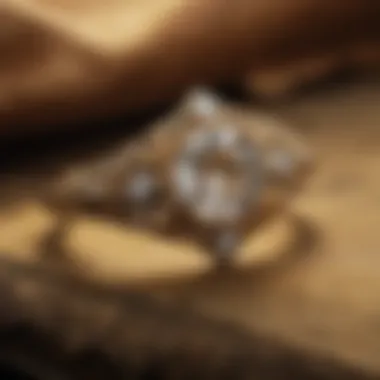
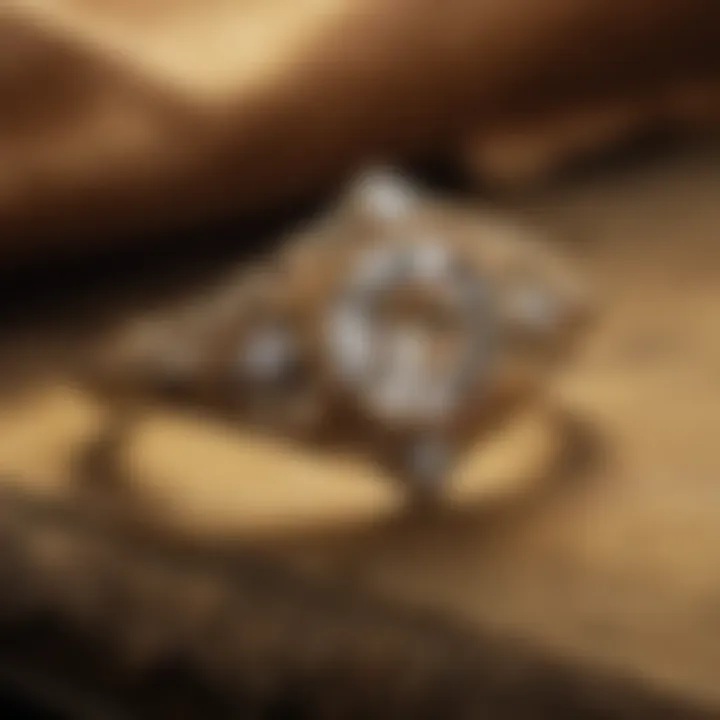
The Emotional Significance Behind Engagement Rings
Engagement rings are not merely pieces of jewelry but rather profound symbols of love, commitment, and personal stories. In the Victorian era, this emotional significance was particularly pronounced, reflecting societal beliefs and practices surrounding love and marriage. Understanding this dimension adds depth to our appreciation of gold Victorian engagement rings, allowing us to see how they served not just as adornments, but as vessels of emotion and intention.
Victorian Beliefs About Love and Marriage
The Victorians had a unique take on love and marriage—a marriage was not just a bond between two individuals but rather a complex interplay of family, societal expectations, and personal emotions. At the heart of this was the idea of courtly love, a romantic ideal that celebrated the deep, passionate feelings one could have for another.
Victorians believed in love that could transcend mere attraction. They valued emotional connections over physical ones, viewing marriage as a sacred union enriched with affection and loyalty. This belief system influenced the designs of engagement rings during that era. Couples often chose elaborate rings that were more than mere tokens; they were expressions of silent promises shared between lovers. Gold rings, particularly, were used symbolically, signifying purity and worth, embodying the couple’s commitment to each other.
Giving and Receiving: Cultural Practices
In the Victorian context, the act of giving and receiving an engagement ring held significant cultural weight. The practice of presenting an engagement ring was rooted in long-standing traditions, extending back centuries. It wasn't just about placing a ring on a finger; it was a formal declaration of intent, stitched with social norms and emotional aspirations.
Key Practices of Engagement Ring Traditions:
- Public Display of Commitment: Presenting a ring in a public setting was a testament to a couple's commitment. It served as a social announcement that they were to be wed.
- The Role of Families: Family support was vital. Engagements often involved negotiations between families, ensuring that the union would benefit both parties socially and financially.
- Regifting and Heirlooms: Many engaged couples would inherit rings from previous generations, imbuing them with even greater emotional significance. The passage of a ring symbolized not just love but continuity and shared history.
Revival of Victorian Styles in Modern Jewelry
The revival of Victorian styles in modern jewelry brings forth a compelling blend of elegance and nostalgia. As trends shift, there's a growing appreciation for design elements from history, particularly those emerging from the Victorian era. This section explores not just the aesthetics, but also the underlying reasons why these styles resonate in today’s jewelry market.
Victorian engagement rings possess intricate designs that are deeply rooted in significant cultural contexts. They carry stories and sentiments that are timeless, which is why they have regained popularity among contemporary consumers. This shift toward retro revivalism reflects the desire of many to connect with past values—particularly when it comes to love, commitment, and artistry. Ring designs from this period embody a certain romanticism that many find appealing. They establish a bridge between the past and present by marrying classic artistry with modern nuance.
Contemporary Designs Inspired by the Past
Today, many jewelry designers are tapping into Victorian influences to craft stunning pieces that hold historical significance while embracing modern craftsmanship.
- Filigree Work: This delicate technique, popular during the Victorian period, allows designers to create lightweight pieces that are intricate and full of character.
- Color Variations: Elements like rose gold and antique finishes are reinterpreted, making modern Victorian-style rings wearable for diverse occasions.
- Personalized Engravings: The idea of adding personal sentiment through engravings draws heavily from Victorian traditions where messages of love were often hidden in the design.
These innovations not only breathe new life into old traditions but also attract a demographic that values both the aesthetic and emotional narratives these rings hold.
Consumer Trends and Preferences
Shifts in consumer preferences indicate a notable trend toward sustainability and ethical sourcing. Busy millennials and Gen Z shoppers are increasingly mindful of the stories behind their jewelry purchases.
- Sustainable Materials: Many consumers prioritize ethical sourcing, cleaning up the supply chain. This aligns perfectly with Victorian themes, as people seek responsible practices while still investing in timeless pieces.
- Customization: There's a rising demand for bespoke items, permitting buyers to reflect personal meaning in their jewelry. This echoes the Victorian practice of having unique touches on engagement rings.
- Emphasis on Vintage Charm: As vintage styles become more desirable, younger generations are drawn to the authentic craftsmanship that defined the Victorian era.
In summary, the charm of gold Victorian engagement rings is not just trapped in nostalgia; it captivates a new audience through innovation, personalization, and responsible practices.
"Jewelry, as a reflection of society, shows how history can inform the art and design that captivates us today."
As we look ahead, it's evident that the allure of Victorian styles will continue to shape the design landscape for years to come.
Maintaining Gold Victorian Engagement Rings
Preserving the beauty and integrity of gold Victorian engagement rings isn't just about keeping them shining or looking brand new. It's a crucial practice steeped in respect for history and craftsmanship. Maintaining your ring ensures that it can be cherished for generations and keep its sentimental value intact. Additionally, regular maintenance can help prevent costly repairs or damage that could happen over time due to neglect.
Gold Victorian engagement rings often carry an emotional weight; they serve as timeless artifacts that link us to our past. Proper maintenance enhances their allure and allows wearers to display their unique pieces without worry.
Cleaning and Care Practices
When it comes to cleaning these delicate pieces, less is more. You don’t need harsh chemicals that could potentially tarnish or damage the gold. Instead, a simple mixture of warm water and mild dish soap should do the trick. Here are some steps to follow:
- Gather Your Supplies: A soft, lint-free cloth, a bowl, and mild soap are all you need.
- Prepare the Cleaning Solution: Mix a few drops of gentle dish soap in warm water.
- Soak for a Short While: Set the ring in the solution and let it soak for about 10 to 15 minutes.
- Gently Clean: Use the cloth to wipe away any dirt or oil without scrubbing too hard, especially on intricate engravings.
- Rinse Thoroughly: Rinse in clean lukewarm water to remove any soap residue. Make sure to plug the drain or do this in a bowl to avoid loss.
- Dry Carefully: Gently pat dry with another soft cloth, ensuring it’s free from moisture, which can lead to tarnishing.
Furthermore, if the ring has gemstones, ensure you are aware of their specific care needs, as some stones can be more delicate or sensitive than others. Regular cleaning not only maintains the aesthetic but also checks for any loose stones or damage that might need addressing promptly.
"Taking care of your gold Victorian engagement ring is not just about maintenance; it's also about honoring the craftsmanship and history it embodies."
Storage Recommendations
Proper storage is key to preserving the splendor of these rings. Instead of tossing them into a jewelry box, consider the following guidelines:
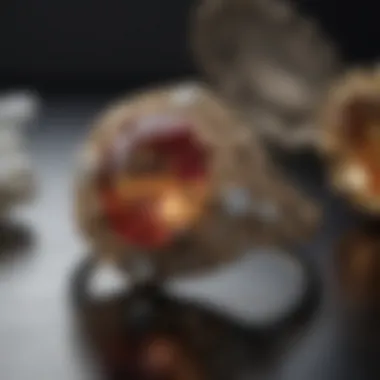
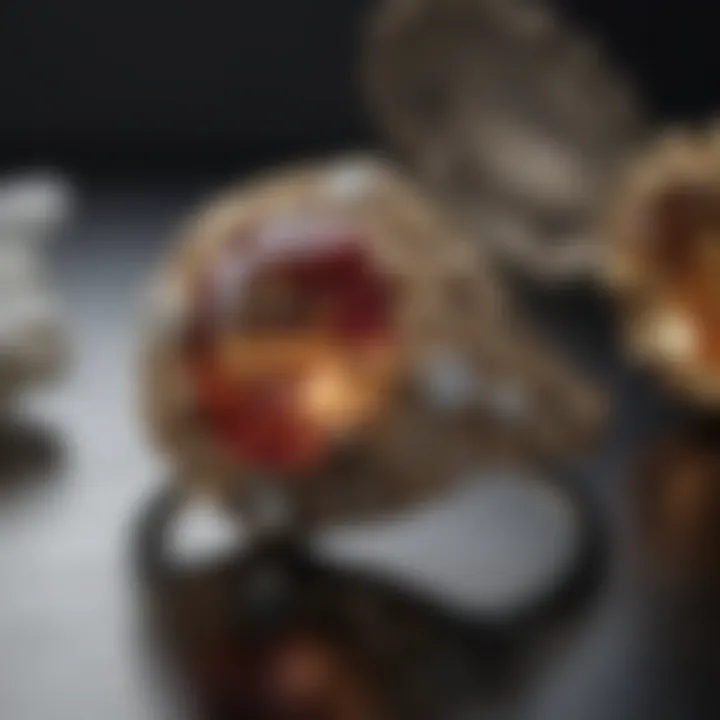
- Use a Soft, Lined Case: Always store the ring in a soft-lined jewelry box or a dedicated fabric pouch. This minimizes the risk of scratches.
- Avoid Excessive Moisture: Keep the rings in a dry place; damp environments can harm gold and any inlaid stones.
- Separate Storage: If you have multiple items, store the ring separately from other jewelry to prevent potential scratching or tangling with sharper edges.
- Temperature Control: Store in a location with stable temperatures. Extremely high or low temps can affect metals over time.
- Regular Checks: Periodically inspect the storage condition to ensure your ring remains safe and secure.
Following these cleaning and storage recommendations will not only keep your gold Victorian engagement rings looking lovely but also preserve their place as a cherished legacy.
Styling with Gold Victorian Engagement Rings
Styling with gold Victorian engagement rings is an art, enhancing not only the ring itself but also the overall aesthetic of an outfit. These rings marry history with personal expression, making them a statement piece for various occasions. Understanding how to stylize rings can fruitsfully impact both confidence and the impression one leaves.
When integrating these vintage rings into modern fashion, several elements emerge as important considerations. Firstly, the intricate design of Victorian rings doesn’t just stand alone; it's essential to create a complementary environment for the ring to shine in all its glory.
Pairing with Other Jewelry
Pairing gold Victorian engagement rings with other jewelry can be a delicate balance. Wearing too many pieces at once might overshadow the beauty of the ring, while too few can make the overall appearance feel incomplete. Here are some key strategies:
- Layering: Consider stacking simple gold bands alongside your Victorian engagement ring. This creates a rich, yet subtle, look that draws attention to the details of the primary ring.
- Material Harmony: Mixing gold with silver or rose gold can elevate the ensemble. The key is to ensure that mixing yields a cohesive appearance. Similarly, gemstone choices in your other jewelry can resonate with the central piece's characteristics, though ensure they complement rather than compete for attention.
- Theme Consistency: If your Victorian ring features floral motifs, consider earrings or bracelets with similar themes for a harmonious look. Accessories that share common motifs with a ring create a storytelling aspect to your outfit – like the past whispering through your present attire.
Outfit Considerations
Your outfit also plays a crucial role in styling Gold Victorian engagement rings. Here’s how to outfit appropriately:
- Color Palette: Neutral hues allow gold to shine, while soft pastels can amplify the vintage feel. Vintage-inspired attire such as lace or soft fabrics can often enhance the ring's charm, embracing elegance for various occasions.
- Style Matching: A formal gown lends a different aura compared to a casual ensemble. Opt for flowing silhouettes paired with the intricate designs of Victorian rings to evoke a sense of grace. For everyday wear, a stylish blouse combined with tailored pants can bring a subtle elegance.
- Occasion Relevance: Always consider the event's nature. A Victorian engagement ring shines in both formal settings, like weddings and galas, as well as in less formal gatherings. Casual outings can be effortlessly enhanced with smart-casual attire that incorporates the ring without overwhelming the overall look.
"A delightful fusion of contemporary fashion and historical charm can turn a simple ring into the centerpiece of your outfit."
By considering these pairing techniques and outfit choices, you’ll create looks that realize the true allure of gold Victorian engagement rings. Instead of just wearing a ring, you’ll embody a narrative that captivates attention and showcases your unique style.
Future Trends in Victorian Engagement Rings
As fashion evolves, so does the interpretation of Victorian engagement rings. These relics from the past don’t merely sit in display cases; they adapt to cultural shifts in values and aesthetics. Understanding future trends in Victorian engagement rings helps both buyers and creators align their choices with the values of contemporary consumers. Key aspects include a growing focus on sustainability, technological advancements in crafting, and personalized design practices.
Sustainable Practices in Gold Sourcing
With increasing awareness about environmental impact, jewelers are shifting their focus toward sustainable gold sourcing. The traditional mining processes have often resulted in significant ecological disruption and social challenges. However, the trend now leans towards sourcing gold from recycled materials or responsible mines. Buyers today are more discerning, willing to pay a premium for rings that have a positive impact on the environment.
Employing practices such as:
- Recycled Gold: Using previously owned gold. This significantly reduces demand on new mining operations.
- Ethically Sourced Gold: Ensuring that the gold comes from mines or operations that respect fair labor standards and minimize damages to the environment.
- Transparency in Supply Chains: Brands now strive to provide complete transparency in how their gold is sourced. This assurance adds value, making consumers feel more connected to their purchase.
As the demand for eco-friendly options rises, more artisans incorporate sustainable practices. This evolution adds an extra dimension of allure for modern couples, emphasizing that their engagement rings not only signify love but also reflect a responsibility towards the planet.
Technological Innovations in Jewelry Making
Today’s technology has turned what was once painstaking handcrafting into a blend of art and precision through advanced methods. Innovative techniques like 3D printing and computer-aided design (CAD) bring a new level of intricacy and personalization to Victorian engagement rings. This intersection of tradition and technology paves the way for unique, bespoke pieces.
Some technological trends include:
- 3D Printing: Allows for rapid prototyping of intricate designs, bringing unique visions into tangible formats.
- Computer-Aided Design: Jewelers can now create detailed models before the actual crafting process begins, ensuring that every intricate detail is precisely executed.
- Lab-Created Gemstones: Offering ethical alternatives to traditional stones, these lab-grown options provide buyers with more choices in terms of both performance and environmental impact.
These innovations offer exciting opportunities for customization, allowing buyers to choose designs that resonate with their personal stories while maintaining the vintage charm of Victorian aesthetics.
"The intersection of sustainability and technology not only elevates the craftsmanship of Victorian engagement rings but also deepens their emotional significance for a new generation of buyers."
Culmination
Engagement rings are more than just jewelry; they carry profound meanings shaped by historical contexts and cultural evolutions. Gold Victorian engagement rings stand as a testament to this narrative, intertwining aesthetics with rich symbolism. In this article, we have journeyed through the captivating landscape of these rings, from the gold types that define their essence to the intricate designs that echo the past.
The continued allure of these rings lies in their craftsmanship that often embodies a familial or heirloom quality, a heartfelt connection spanning generations. Their ability to marry old-world charm with contemporary allure makes them a favorite among collectors and enthusiasts alike.
Why do Gold Victorian engagement rings endure?
Why Gold Victorian Engagement Rings Endure
Timeless Appeal: These rings exude a timeless quality, deftly combining classical designs with precious materials. The way they capture the essence of love and commitment resonates deeply with couples even today.
Symbolism and Meaning: Each element of a Gold Victorian engagement ring, from the choice of gold to gemstone selections, is laden with significance. They often symbolize enduring love, unity, and fidelity, which makes them highly sought after and treasured.
Cultural Heritage: Owning a Victorian ring is like possessing a piece of history. Enthusiasts appreciate the craft techniques that have been preserved over generations, making these pieces not just adornments, but also artifacts of a bygone era.
Revival in Modern Jewelry Design: Designers today often draw inspiration from Victorian motifs, ensuring that these pieces find their way into modern collections. This seamless blend of art and history appeals to those looking for unique jewelry that narrates both personal and collective stories.
In summation, Gold Victorian engagement rings will continue to captivate for their remarkable beauty and the compelling stories they encapsulate. They maintain a cherished place not just in fashion but in the hearts of those who wear them.







